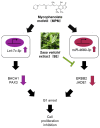Sasa veitchii Extract Mitigates Mycophenolate Mofetil-Induced Human Palatal Cell Proliferation Inhibition by Downregulating microRNA-4680-3p
- PMID: 40219219
- PMCID: PMC11991523
- DOI: 10.3390/plants14071150
Sasa veitchii Extract Mitigates Mycophenolate Mofetil-Induced Human Palatal Cell Proliferation Inhibition by Downregulating microRNA-4680-3p
Abstract
Cleft palate is a common birth defect worldwide and is caused by both genetic and environmental factors. Intrauterine drug exposure is one of the environmental factors that can induce cleft palate. Mycophenolate mofetil (MPM) is an immunosuppressant drug with teratogenic effects, including cleft palate. However, the research on MPM-induced cleft palate remains limited. Sasa veitchii extract (SE), a medical plant extract, is commercially available in Asia and has been reported to show effectiveness against oral diseases. The purpose of the present study is to evaluate whether SE protects against MPM-induced immunosuppression in human embryonic palatal mesenchymal (HEPM) cells. Cell viability and G1 phase-related cell cycle markers were assessed by co-treatment with MPM and SE. Furthermore, we quantified cleft palate-associated miRNA levels and the expression of its downstream genes. MPM treatment reduced cell viability in a concentration-dependent manner. Co-treatment with SE alleviated MPM-induced inhibition of HEPM cell proliferation. Additionally, SE reduced MPM-induced miR-4680-3p upregulation and the downregulation of its downstream genes (ERBB2 and JADE1). These results suggest that SE alleviated MPM-induced cell proliferation inhibition through modulating miR-4680-3p expression.
Keywords: Sasa veitchii; cell cycle; cleft palate; microRNA; mycophenolate mofetil.
Conflict of interest statement
The authors declare no conflicts of interest.
Figures







Similar articles
-
Protective effect of Sasa veitchii extract against all-trans-retinoic acid-induced inhibition of proliferation of cultured human palate cells.Nagoya J Med Sci. 2024 May;86(2):223-236. doi: 10.18999/nagjms.86.2.223. Nagoya J Med Sci. 2024. PMID: 38962411 Free PMC article.
-
Cleft Palate Induced by Mycophenolate Mofetil Is Associated with miR-4680-3p and let-7c-5p in Human Palate Cells.Noncoding RNA. 2025 Feb 6;11(1):12. doi: 10.3390/ncrna11010012. Noncoding RNA. 2025. PMID: 39997612 Free PMC article.
-
Sasa veitchii extracts protect phenytoin-induced cell proliferation inhibition in human lip mesenchymal cells through modulation of miR-27b-5p.Biomed Res. 2023;44(2):73-80. doi: 10.2220/biomedres.44.73. Biomed Res. 2023. PMID: 37005285
-
Involvement of microRNA-4680-3p against phenytoin-induced cell proliferation inhibition in human palate cells.J Toxicol Sci. 2024;49(1):1-8. doi: 10.2131/jts.49.1. J Toxicol Sci. 2024. PMID: 38191190
-
Cell cycle proteins in normal and chemically induced abnormal secondary palate development: a review.Hum Exp Toxicol. 2006 Nov;25(11):675-82. doi: 10.1177/0960327106070848. Hum Exp Toxicol. 2006. PMID: 17211986 Review.
References
-
- Van Gelder M.M., van Rooij I.A., de Jong-van den Berg L.T., Roeleveld N. Teratogenic mechanisms associated with prenatal medication exposure. Therapie. 2014;69:13–24. - PubMed
LinkOut - more resources
Full Text Sources
Research Materials
Miscellaneous

